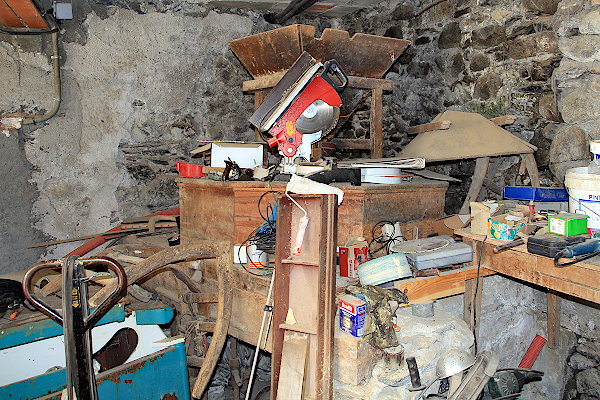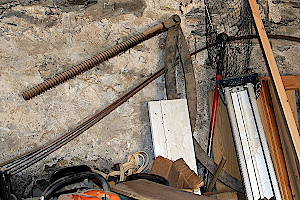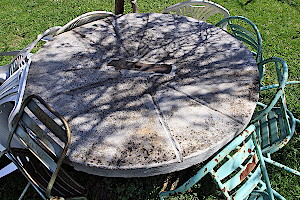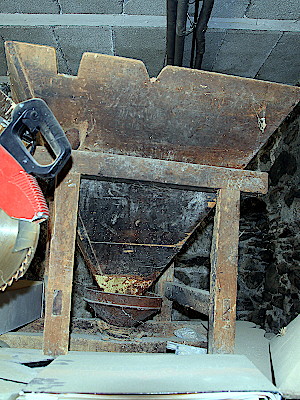Mills in Alto Aragón - harinero
Eriste
Eriste is a small village in the
Valle de Benasque which is in the Ribargorza county of Huesca province. Benasque is
a very popular holiday destination and you should find it easily on any map at hand. Eriste is a couple of kilometers
more to the South, next to the Embalse de Linsoles. There is parking space along the main road. Walk from there
towards the hydropower plant. Stay on the main road, cross the outflow of the power plant and take the
road to the left (calle Poblado Eiasa). You will walk over the outflow again. Now turn right and stay on the left bank of
the
Río Eriste. You are now in the Camino del Molino which will bring you to
the site of the mill (and the Carpinteria El Molino).
Pictures: 09.IV.2015
What remains of the installations of the mill
occupies only a small part of a large complex (1, 2) consisting of buildings for work and for living.
The hurst frame (bancada, 3) is located
in the section with the smooth grey front wall (right in 2) and the turbine was installed
in the part built with natural stone (2 left). We don't know if the turbine is still present. Probably not, given the work that
has been done.
During the many changes in the construction, one
corner was carefully left untouched: the site with the hurst frame of the flour mill (3). Though
it is burried below lots of tools and discarted objects, the equipment is complete and in good
condition.
There is a solid octogonal dustcover (guardapolvo) with on top of it a nice wooden horse (caballete, 7) which carries a wooden
feeder hopper (tolva, 7). The lower part of the hopper has been carefully repaired with some metal plating (yellowish in 7).
The stone crane has been taken apart and the arms (5) are stowed
away against the backwall of the place.
A nice couple of cog wheels (4) are resting beneath the stones. Notice the wooden cogs which must
reduce possible damage to the system should a sudden halt occur. The system which allows to tune the distance between the
stones, the tentering gear or aliviadora (4), is also present.
From right to left an iron rod (4) can be seen which runs through the wall to the section of the construction
which is built with natural stone (2). We had no access to this part of the mill, but we know that there
must have been, or maybe stil is, a turbine at the other side of the wall because we can see the drain
from outside (10).
The turbine ran on water of the Río Eriste brought to the mill with a wide canal on the left bank (11).
Near the property an old warning sign can be found (8). It says that the
mill is private property (
finca particular). The drawing in the upper half of the sign is remarkable: a grinder with
three conical stones. Such a device is typical for a mill where oil is pressed from olives. However, as far as we know, the mill at hand has never
been in the oil business.
But several sources do mention this mill in relation to the production of electricity.
In the early 20th century the mill was listed as a flour mill only.
The entry in the yellow pages of the time reads:
Sahún: Harinas. — Peres (Felix).
(
†).
In the Guía of 1924 (
‡) we find that the mill then is generating electricity also and
provides electric lighting to the village of Sahún - Eriste:
Sahún: alumbrado eléctrico
and
Eriste: Electricidad (Fábrica). — Félix Peré. Notice that the owner
is the same person in both cases. The way of writing names was quite variable in listings of that period.
In the 1940s the electricity installations where managed by a community
of owners (
☨). In the 1960s there was a wave of expropriations in Eriste due to the construction of
the hydroelectric powerstation that was built in 1972. Because of this and because there was a constant need for
renovations in the business, the community shrank to a handful of members and the activities were reduced to the distribution of electricity
only. Eventually this became Eléctrica de Eriste which is still in business today and provides more than 500 households in Sahún, Eriste
and Linsoles with energy (
☨).
In 2017 Eléctrica de Eriste was looking
into production again and asked permission to build its own mini powerstation in a
valley nearby, but that permission was not granted based on the negative impact on the environment and the fact that there are already
so (maybe even, too) many energy production installations in the neighbourhood of Benasque and the Parque Natural de Posets-Maladeta.
† D.E.Bailly-Bailliere, editor — 1911 — Annuario del Commercio de la Industria,
de la Magistratura y de la Administracion de España y sus colonias. Madrid. Casa Editorial Bailly-Bailliere. Año XXXIII: 5618pp.
‡ Roman Garcia Garate — 1924 — Guía general de Aragón, Navarra,
Soria y Logroño. Huesca. Editorial V. Campo. 738pp.
☨ Eléctrica de Eriste S.L.
website at http://electricadeeriste.com accessed on 09.IV.2020.














